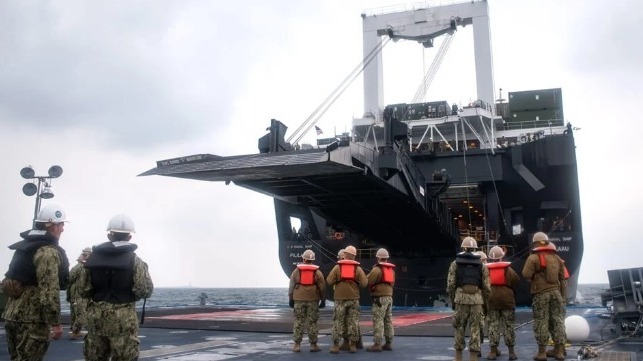UN, Aid NGOs Dismiss Biden Administration's Floating Pier for Gaza

Aid agencies and UN officials have panned the Biden administration's plan to build a temporary pier in Gaza for emergency relief, arguing that trucking from Egypt would be more efficient - and that the same goods are already waiting on trucks at the border.
“When I read about the pier, my reaction was: really?” Deepmala Mahla of CARE International told Devex. “First air drops, and now a floating pier, all when we have hundreds and thousands of [trucks with] food and other required material just miles away from the border, all ready to get in?”
According to Mohammed Abdel-Fadeil Shousha, governor of Egypt's North Sinai province, there are currently about 7,000 aid trucks waiting to transit an Israeli-operated checkpoint and enter Gaza from the south. The Israeli government has clamped down on aid truck transits for weeks, and it recently cut off all Northern Gaza access for UNRWA, the UN Palestinian aid agency. Israel accuses UNRWA of harboring members of terrorist group Hamas.
UN Secretary-General Antonio Guterres has called on Israel to allow more aid into Gaza in order to head off an impending famine.
"The only efficient and effective way to move heavy goods is by road. It requires an exponential increase in commercial goods," said Guterres on Sunday, speaking during a diplomatic trip to Cairo.
Maritime transport can move far heavier goods than road transport can, but the volume is dependent upon port infrastructure. Since Gaza lacks commercial seaport infrastructure within its own borders, and its borders are closed, the White House has organized a sealift effort to deliver aid via a novel maritime route. The U.S. Navy, U.S. Army and Military Sealift Command will install a floating causeway and a receiving platform for lightering off Gaza's coast. This Joint Logistics Over The Shore (JLOTS) operation is in motion and should be in place within 60 days. No American boots will touch the ground, the White House insists. The total cost has not been released.
Commercial port infrastructure is already available and could be utilized, aid advocates say, if Israel would allow final-mile trucking past the land border. The full-service container terminal at Port Said is just four hours from Gaza, and the small multipurpose port of Arish is less than an hour from the crossing - but both are on the wrong side of the border.
"[The food crisis is] not due to the lack of supplies, and it’s not due to the lack of partners who want to bring them in," Mercy Corps VP of Policy Kate Phillips-Barrasso told Devex. "It’s entirely due to the conditions that have been set with the entry of aid in through those land crossings — some of which, I might add, would not be different than the aid that would enter through a maritime corridor."
The decision to limit truck crossings lies in part with Israeli Security Minister Itamar Ben Gvir. In public comments, Ben Gvir has advocated restricting food and medical aid deliveries to Gaza until after Hamas agrees to release its remaining Israeli hostages. In late February, after a failed truck convoy operation, he argued that allowing humanitarian aid to enter the Gaza Strip is "madness" until the last Israeli abductees are safely returned.
